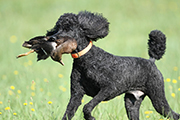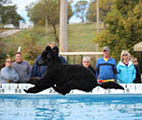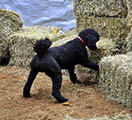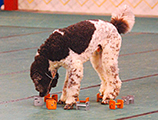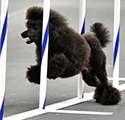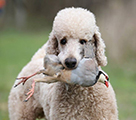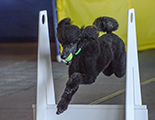Fact Sheet
Juvenile Renal Disease in the Standard Poodle
-a review (1994)
By Grace L. Blair, M.D.
Introduction
The first and only report of familial JRD in the Standard Poodle in the literature appeared in 1983. Since then there have been sporadic anectdotal reports by a few owners of young Standard Poodles dying of renal failure and a very few breeders have noted an occassional litter where more than one young dog died of the disease. This report is a review of the literature dealing with JRD in various breeds of dogs with an emphasis on the Standard Poodle and a suggestion for future research.
Clinical Presentation
It appears from the clinical and histological information currently available that there are at least two different types of JRD in the various breeds of dog affected.
A familial juvenile onset of renal amyloidosis has been identified in the Beagle and the Chinese Shar Pei. In the Beagles the clinical symptoms of renal failure developed after 5 years of age and was characterized by lethargy, anorexia, vomiting and weight loss with anemia, hypoalbuminemia, azotemia, proteinuria, and inability to concentrate the urine. In the Chinese Shar Pei the usual first symptoms were recurrent fever of unknown origin and intermittent joint swelling and then later the development of renal failure. The symptoms and findings in these Chinese Shar Pei dogs were similar to that seen in familial Mediterranean fever in humans, which is an inherited autosomal recessive trait.
The second, and more commonly seen familial JRD is seen in Bull Terriers, Rottweilers, Chow Chows, Norweigein Elkhounds , Doberman Pinschers , Standard Poodle, Lhasa Apso and Shih Tzu. In these breeds of dogs the disease is characterized by the onset usually appearing prior to two years of age with death following within several months after onset. The disease is characterized by the usual symptoms of renal failure with anemia, lethargy, weight loss, vomiting, azotemia, and a failure to concentrate the urine.
Pathologic Evaluation
Microscopic examination of the dogs exhibiting renal amyloidosis had Congo Red positive material of moderate to severe degree in the glomeruli as well as medullary interstitial amyloidosis. Many of the amyoid deposits were sensitive to potassium permanganate oxidation, which suggested the presence of amyloid protein AA. In the breeds of dogs not exhibiting renal amyloidosis a generalized renal fibrosis and atrophy was seen. In the Rottweilers an atrophic glomerular lesion was noted which was distinct from that seen in the other breeds. The remaining breeds showed an interstitial fibrosis, variable tubular atrophy, tubular dilitation tubular basement membrane mineralization, immaturity of glomeruli and inconspicuous capillary lumens. Picut and Lewis reported a nice ultrastructural study in the Doberman Pincher which closely correlated with the microscopic findings by DiBartola et. al. in the Standard Poodle. Based upon similar ultrastructural changes in other hereditary nephropathies seen in man and dogs Picut suggested a metabolic or biochemical basis for the structural lesions found.
Heredity
In these reports there are usually a minority of puppies from a litter affected, often the parents are related and there may be a recollection of one of the grandparents having produced a sporadic case. This seems to indicate an autosomal recessive mode of inheritance. In one report of a mixed breed litter all members of the litter died of progressive renal failure before one year of age. This, statistically, could also represent an autosomal recessive heredity. There were 5 or 6 in the litter and it was thought that the parents were a Shih Tzu and a St. Bernard. Pedigree evaluations conducted by Susan Fleisher and Lynn Brucker indicate that the disease is inherited as an autosomal recessive in the Standard Poodle.
Diagnosis and Discussion
In the Norweigian Elkhound, Finco et. al. found that histopathological evaluation was reliable for detecting disease in dogs prior to onset of clinical symptoms and prior to development of azotemia. They found that the nephron numbers and size were normal early on, but that the numbers decreased as the disease progressed. Elevated BUN and creatinine blood levels occur late into the disease so are not good early predictors of those puppies who will become affected with JRD. Inability to concentrate urine is probably a better early non-invasive determinant of renal disease. However, young mammals all have immature kidneys and are unable to concentrate their urine to the degree found in older animals. To do renal biopsies on all young puppies is not cost effective and the risk outweighs the benefits. Doing necropsies on puppies born dead is probably not helpful, as even anephric animals can live 3 or 4 days after birth. Certainly it would be helpful to have a microscopic examination of the kidney and adrenal of puppies which die of the “fading puppy syndrome” in the first 8 weeks of life. A limited microscopic examination is not terribly expensive and could uield valuable information.
More questions remain than answers regarding this disease. How can we find carriers? How can we find dogs affected before they are sold to their new homes? If the puppy is born normal, at what age do the pathologic changes begin to be detected and at what age should we begin doing renal function tests? Is there an enzyme abnormality in the blood or urine that we can measure which will be a predictor of disease? If so, is it also present to a lesser degree in carriers? Or is there an absence of a particular enzyme or protein in affected dogs?
Conclusions
JRD is a uniformly fatal disease in a variety of breeds of purebred and mixed-breed dogs. It appears to be an autosomal recessively inherited disorder. The non-amyloidosis type of disease is found in more breeds. A research study on at least two test litters from carrier parents would help to conclusively determine the mode of inheritance and aid in the development of a method to diagnose the disease in the early stages. Early renal biopsies, regular blood evaluations, and an extensive investigation of possible enzyme and/or protein abnormalities in the members of the litter and their relatives could be undertaken. Investigators interested in biochemical and clinicopathologic manifestations of hereditary renal disease should be identified. This is a worthy project for funding by a National Breed Club. If the true mode of inheritance and a method of early diagnosis can be determined then it would be appropriate to request that the Genetic Disease Registry at the University of California, Davis add this disease to those in their open registry and a search for the DNA diagnosis of the carrier state could be undertaken.
References:
DiBartola SP, Chew DJ, Boyce JT, Juvenile Renal Disease in Related Standard Poodles. J. Am Vet Med Assoc (1983 Sept 15) 183(6):693-6
Bowles MH, Mosier DA, Renal Amyloidoses in a Family of Beagles, J. Am Vet Med Assoc. (1992 Aug 15) 201(4):569-74
DiBartola SP, Tarr MJ, Webb DM, Giger U, Familial Renal Amyloidosis in Chinese Shar Pei Dogs, J. AM Vet Med Assoc (1990 Aug 15) 197(4):483-7
Rivas AL, Tintle L, Meyers-Wallen V, Scarlett JM, van Tassell CP, Quimby FW, Inheritance of Renal Amyloidosis in Chinese Shar-pei Dogs, J. Hered (1993 Nov-Dec) 84(6):438-42
Robinson WF, Shaw SE, Stanley B, Huxtable CR, Watson AD, Friend SE, Mitten R, Chronic Renal Disease in Bull Terriers, Aust Vet. J. (1989 Jul) 66(7):193-5
Cook SM, Dean DF, Golden DL, Wilkinson JE, Means TL, Renal Failure Attributable to Atrophic Glomerulopathy in Four Related Rottweilers, J. Am Vet Med Assoc (1993 Jan 1) 202(1):107-9
Brown CA, Crowell WA, Brown SA, Barsanti JA, Finco DR, Suspected Familial Renal Disease in Chow Chows, J. Am Vet Med Assoc (1990 Apr 15) 196(8):1279-84
Finco DR, Duncan JD, Crowell WA, Hulsey ML, Familial Renal Disease in Norweigian Elkhound Dogs: Morphologic Examinations. Am J Vet Res (1977 Jul) 38(7):941-7
Finco DR, Ramilial Renal Disease in Norweigian Elkhound Dogs: Physiologic and Biochemical Examinations, Am J. Vet Res (1976 Jan) 37(1):87-91
Picut CA, Lewis RM, Juvenile Renal Disease in the Doberman Pinscher: Ultrastructural Changes of the Glomerular Basement Membrane, J. Comp Pathol (1987 Sep) 97(5):587-96
Chew DJ, DiBartola SP, Boyce JT, Hayes HM Jr, Braace JJ, Juvenile Renal Disease in Doberman Pinscher Dogs, J. Am Vet Med Assoc (1983 Maar 1), 182(5):481-5
Copyright 1994 Dr. Grace Blair, used by permission
The information contained in these documents is current at the time of this writing and is accurate to the best of VIP’s knowledge.
This information has been provided to you at no charge. You are free to use it provided it is used in its entirety with no changes or alterations and that the copyright remains intact. If you have found this information to be helpful, please consider making a tax-deductible donation to:
Versatility in Poodles
4061 Highlands Rd
Franklin, NC 28734
To make a donation via PayPal, please click the Donate Button:
![]()
The contents of the www.vipoodle.org website, such as text, graphics, images, and other material contained on this site (“Content”) are for informational purposes only. The Content is not intended to be a substitute for professional veterinarian advice, diagnosis, or treatment. Always seek the advice of your veterinarian with any questions you may have regarding the medical condition of your pet. Never disregard professional advice or delay in seeking it because of something you have read on this website!
If you think your pet has a medical emergency, call or visit your veterinarian or your local veterinary emergency hospital immediately. Versatility in Poodles and www.vipoodle.org do not recommend or endorse any specific veterinarians, products, procedures, opinions, or other information that may be mentioned on this website. Reliance on any information appearing on this website is entirely at your own risk.





